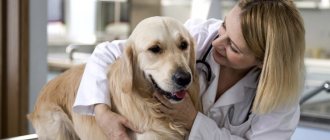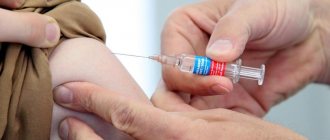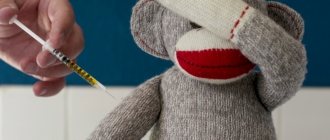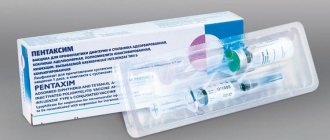Dog vaccinations are a necessary procedure, the purpose of which is to prevent the development of a number of serious diseases to which pets are susceptible. The reaction to injections can be different: for some animals the vaccination process does not cause discomfort, for others it is accompanied by complications.
One of the most common consequences of medical manipulation is the appearance of a bump on the dog’s withers. It usually does not bother the animal, and experts and owners regard this phenomenon as quite common. As a rule, the instructions for vaccines state: “ The formation of a small infiltrate at the injection site is considered a normal vaccination reaction and does not require special treatment. The infiltrate resolves on its own within a week .”
If the lump does not enlarge or become inflamed, then there is no reason to worry - the injection solution injected under the skin requires time to resolve, and this will happen in about 30 days.
But if the lump has grown or changed color, then this is already a reason to visit the veterinarian!
Why do dogs get a lump after injections - special cases
A bump on the withers after vaccination may appear due to certain factors:
- Unprofessional administration of a medicinal solution. It cannot instantly dissolve, and this leads to tissue compaction.
- Short needle. Insufficient size allows the composition to penetrate into the subcutaneous layer, as a result of which it is not able to distribute evenly throughout the tissues.
- Poor quality vaccine, violation of its storage conditions, exceeding the expiration date.
- Allergic reaction of the dog's body to the composition.
- Damage to a blood vessel or nerve ending during injection.
- The dog was not healthy at the time of vaccination.
- Medical error during chipping.
As a result of these unforgivable mistakes, the dog may develop a purulent focus or abscess at the vaccination site, which manifests itself as a compaction on the withers.
Is it possible to prevent bumps from appearing on a dog after vaccination or injection?
You can avoid the appearance of seals on your animal’s withers after injections if you follow simple rules:
- try to calm the dog as much as possible before vaccination;
- use only sterile syringes that are suitable for injections in animals;
- carefully and not very quickly administer the drug;
- If possible, try not to touch the pet’s fur with the needle, and before the injection, treat the injection site with an antiseptic solution.
If your dog does develop a lump at the vaccination site, you should not immediately sound the alarm. It is necessary to evaluate the condition of the compaction, the presence of pathological discharge from it, its mobility and pain. Unmodified bumps should not cause any concern for pet owners, as they will resolve on their own over time. Complicated seals that pose a threat to the normal functioning and health of the dog require veterinary care. That is why any alarming manifestations from the lump are a reason for an immediate visit to the veterinary office.
In what cases should you consult a doctor?
A lump in a dog in the area at the withers after vaccination, as mentioned earlier, is not a dangerous phenomenon. No qualified veterinary intervention is required. However, in some cases, compactions may be accompanied by the addition of infectious microflora, in which case a visit to a specialist to eliminate the source of inflammation is necessary.
The dog owner should be alert to the following symptoms:
- after vaccination the lump increased;
- redness and inflammation may have formed in the injection area;
- pain on palpation;
- increased temperature, fever;
- vomiting, diarrhea;
- labored breathing;
- purulent discharge when pressing on the lump;
- deterioration of the dog’s general condition;
- lethargy, lack of appetite.
All these symptoms are regarded as pathological, so monitoring by a veterinarian and prescribing adequate treatment is essential.
Treatment of cones after vaccination
No specific therapy is required; the formation resolves on its own. To reduce discomfort, the injection site is treated once a day with the following medications:
- Levomekol.
- Heparin.
- Menovazin.
More often it is not worth it - this will lead to the wound getting wet. You can give 1 painkiller tablet. If the lump becomes inflamed and yellowish and foul-smelling discharge appears, then an infectious process has begun. The area is treated with antiseptics and antibacterial ointments (local antibiotics).
What to do to prevent your dog from developing a bump on the withers
It is possible to avoid the formation of a seal after vaccination; to do this, it is enough to follow some rules.
The owner needs to calm the animal so that the dog behaves adequately and calmly during the administration of the solution.
On the part of the specialist, maximum compliance with the rules of the procedure is required: the use of sterile injection needles, treating the dog’s skin with an antiseptic, and careful administration of the vaccine.
If a lump forms, do not immediately grab the animal and run to the nearest veterinary clinic. You should evaluate the pet’s health, the degree and mobility of the seal, and check whether fluid is leaking from it. Contact a specialist only if the tumor is of concern and, in your opinion, poses a threat to the normal functioning of the dog.
A bump on the withers after a rabies vaccination - normal or pathological
Rabies vaccination is extremely important. It is done on puppies and adult pets, although it is better to do it at an early age. Only healthy animals without helminthic infestation are allowed to visit it. On the day of vaccination, the temperature is measured and food is limited. Estrus in a female is not a contraindication, but it is advisable to postpone the procedure to a period of rest.
The injection site should be inaccessible to moisture. This is a micro-wound that should not contain dirt or pathogenic bacteria. They are vaccinated against rabies at the withers. A lump is normal if:
- does not increase in size;
- moderately painful;
- disappeared after 7-14 days.
Temporary complications after the procedure: one-time refusal to eat, vomiting or diarrhea; temperature rise to 39.5; lethargy and drowsiness on the day of vaccination. It is also recommended not to leave the clinic for 15-20 minutes after administration of the drug: during this time, an allergic reaction occurs.
Dog after rabies vaccination: rules of rehabilitation
The houses provide rest and constant access to water. It is better to reduce physical activity and protect your pet from communicating with potentially infected people: the vaccine is only effective for 21 days after administration. The animal is not bathed for about 2-3 weeks.
Possible complications after vaccination in dogs
Alarming manifestations during the recovery period:
- severe pain;
- vomiting, stomach disorders;
- a strong increase in temperature (more than 1 degree);
- convulsions;
- cyanosis of the integument;
- redness of the ears and eyes;
- dyspnea;
- discharge of mucus from the eyes and nose.
If these symptoms occur, consult a doctor immediately. They talk about individual intolerance, allergies or low-quality vaccination preparations. The bottle label must be included or pasted into the veterinary passport with a note about the procedure.
What not to do
Having felt a lump in the withers area, owners often perceive it as a pathology and begin to immediately treat the pet by applying ointments and compresses. Therefore, it’s worth saying right away what not to do:
- Massage and press on the swelling;
- Make compresses with vodka or tinctures. They have a warming effect and, if an inflammatory process is hidden under the guise of a lump, they will only aggravate it and aggravate the situation;
- You should not apply cold either - it will slow down the absorption of the drug;
- Moreover, you should not start giving your dog antibiotics and anti-inflammatory drugs.
If, within a few days after vaccination, the dog has a bump on the withers, which does not hurt or cause discomfort to the pet, then the best option is to simply observe the further development of the situation. By the end of the first week you will clearly understand whether your pet needs treatment or not.
Important! Do not allow your pet to scratch the swelling. It can cause infection and the process progresses to purulent inflammation.
Reasons for the appearance of a lump after vaccination
What are the possible causes of a lump after a rabies vaccination? Unfortunately, you are unlikely to know the exact cause of the side effect. The dog’s body may react unconventionally to the vaccine, resulting in tissue swelling.
- The needle may have been inserted too deeply or the vaccine may have been given too quickly.
- In addition, a lump may occur when using vaccine that was previously frozen or exposed to too high a temperature.

When a lump has already appeared, the reasons why it happened are not as important as the consequences. Constantly monitor the condition of the damaged skin and make sure that the lump does not increase. If the swelling causes discomfort to your dog, it is best to consult a veterinarian.
What do you definitely need to pay attention to?
If the seals after the injection in your four-legged friend are accompanied by inflammation, be sure to show the dog to the treating veterinarian for subsequent treatment of the above pathologies. Caring owners should pay attention to the following warning signs.
- Increasing the size of the seal.
- Pain in the injection area.
- Discomfort caused by the appearance of a lump.
- Redness of the injection site, as well as its infiltration.
- Purulent discharge from the cone.
- Deterioration of the pet's general condition.
- Loss of appetite in a dog.
- Apathy.
- Temperature increase.
The above symptoms are considered pathological post-injection manifestations that require monitoring by the attending veterinarian and the appointment of appropriate therapy aimed at their elimination.
Loving owners should pay attention that after the rabies vaccination the dog’s lump will ache a little for approximately 10-14 days, after which it must resolve and disappear without a trace.
What types of complications can a pet expect after vaccination?
In order to correctly respond to changes in your pet’s condition after vaccination, you need to know two main types of the body’s reaction to vaccination: local and general.
The appearance of local complications is normal and should not prompt the owner to take emergency action. The animal may exhibit the following symptoms:
A lump after vaccination in a dog at the injection site. Sometimes it appears after using certain types of vaccines, or if the injection was given incorrectly. depending on the components they contain. It goes away within the next two to three weeks after vaccination. If it does not bother the dog, then its presence can be considered a sign of normality.
The pet may experience pain at the injection site and slight swelling. It does not require any immediate action on the part of the owner and goes away within the next three days.
After vaccination, the dog is lethargic, its body temperature rises to 39°C. It is necessary to ensure calm recovery conditions and the result will not be long in coming within 2-3 days.
If a dog vomits after vaccination or has diarrhea, this may be the body’s reaction to the vaccination. To bring your dog's body back to normal, it is enough to skip one meal.
If the dog feels noticeably worse than in the above situations, then the help of a veterinarian is required. Symptoms of a sharp deterioration of the condition include:
Continuing negative consequences after vaccination. Lethargy becomes more visible and turns into weakness. Convulsions may begin, the animal does not want to eat for a long time. If, after vaccination, the dog has diarrhea that has become protracted (more than 2-3 days), and the body temperature begins to exceed 39°C, then you should immediately contact a specialist.
Difficulty breathing of the animal, excessive salivation. The mucous membranes become pale and swollen. There may be an allergic reaction that goes away after taking antihistamines. Anaphylactic shock occurs not only in humans, so the procedure is the same - prompt hospitalization.
What should pet owners do?
What should owners do if their dog has a lump after vaccination, but there is no way to go to the vet? In fact, there are few options, however, first let’s decide what not to do:
- Do not press on the swelling.
- Do not knock down the fur at the site of the skin lesion, and to make it easier to monitor the growth of swelling, it is better to use a marker.
- Do not heat or cool the bud!
- Do not wet the affected skin.
- Do not use alcohol compresses, rubbing and other folk remedies.
- Don't bandage the bump.
Important! Make sure your dog does not scratch the affected skin. When scratches appear, the inflammation is guaranteed to become purulent.
The only adequate help you can provide if your dog develops a lump after a rabies vaccination is a compress with dimexide. However, this measure is not always relevant. Apply compresses if more than a week has passed since the lump formed or if it increases in size. A compress should be applied if the dog is clearly in pain, the lump causes discomfort or itches. Dimexide will help if there is severe inflammation that turns purulent.
Specific reasons
What factors can cause a dog to develop a lump after vaccination?
- Unprofessional injection administration. In this case, it is difficult for the solution contained in the ampoule to dissolve. This causes tissue compaction.
- Insufficient needle size. With a short needle, the injected veterinary drug enters the subcutaneous layer, which prevents its uniform distribution throughout the tissues.
- Problems with the vaccine: poor quality product; medicine stored without proper conditions; injection used after the permissible period; counterfeit drug.
- Manifestation of an allergic reaction of the dog’s body to the components of the administered drug. Before carrying out the vaccination procedure, each attending veterinarian must once again check the list of substances to which each specific pet has an individual intolerance.
- Damage during puncture of a blood vessel.
- The presence of serious diseases in the pet at the time of vaccination.
The above unforgivable mistakes can provoke the formation of purulent foci or abscesses at the injection site in the animal, manifested in the form of lumps or lumps.











